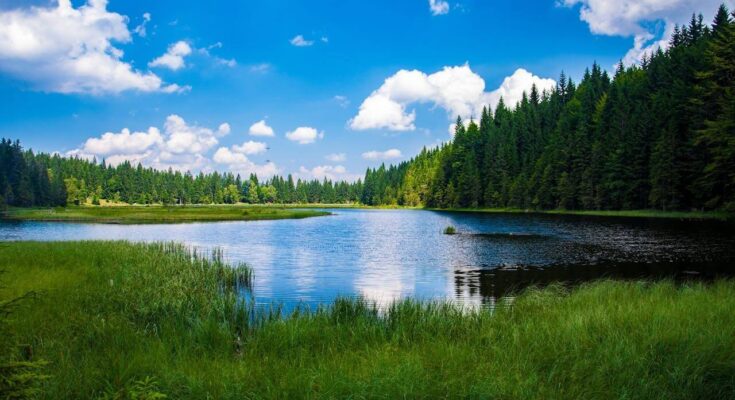Introduction:
Nestled in the northeastern state of Manipur, India, Loktak Lake stands out as a mesmerizing natural wonder, home to the world’s only floating national park, Keibul Lamjao. Within its tranquil waters lies a sanctuary for the critically endangered sangai deer, making it a biodiversity hotspot of global significance. Let’s embark on a journey to uncover the secrets of this unique ecosystem and understand the efforts made to conserve its precious inhabitants.
Discovering Loktak Lake:
Loktak Lake, often referred to as the lifeline of Manipur, spans over an area of approximately 287 square kilometers. Its allure lies not only in its vast expanse but also in the floating phumdis, which are heterogeneous masses of vegetation, soil, and organic matter. These phumdis, constantly shifting and floating on the lake’s surface, create a dynamic environment unlike any other.
Keibul Lamjao National Park:
At the heart of Loktak Lake lies Keibul Lamjao National Park, established in 1977 to protect the unique phumdis and their inhabitants. What makes this national park truly extraordinary is its status as the world’s only floating national park. Here, amidst the labyrinth of floating vegetation, thrives the sangai deer, also known as the “dancing deer” for its graceful movements.
The Enigmatic Sangai Deer:
The sangai deer, Rucervus eldii eldii, is endemic to Manipur and is listed as critically endangered on the IUCN Red List. With its elegant stature and distinctive features, including elongated antlers and a light brown coat, the sangai deer symbolizes the biodiversity richness of Manipur. However, due to habitat loss, poaching, and other anthropogenic pressures, the sangai population faced a severe decline, prompting urgent conservation actions.
Conservation Efforts:
Recognizing the significance of preserving the sangai deer and its habitat, conservation initiatives have been implemented to safeguard Keibul Lamjao National Park. These efforts include habitat restoration, anti-poaching patrols, community engagement, and research to understand the ecological dynamics of Loktak Lake better. Additionally, collaborations between government agencies, local communities, and non-profit organizations have been instrumental in ensuring the long-term survival of the sangai deer and the conservation of Loktak’s fragile ecosystem.
Ecotourism and Sustainable Development:
While conservation remains paramount, Loktak Lake also offers opportunities for sustainable ecotourism. Visitors can explore the lake’s pristine beauty through boat rides, birdwatching, and cultural experiences, contributing to the local economy while raising awareness about the importance of preserving natural habitats.
Discovering Loktak Lake:
Loktak Lake, often referred to as the lifeline of Manipur, spans over an area of approximately 287 square kilometers. Its allure lies not only in its vast expanse but also in the floating phumdis, which are heterogeneous masses of vegetation, soil, and organic matter. These phumdis, constantly shifting and floating on the lake’s surface, create a dynamic environment unlike any other.
Keibul Lamjao National Park:
At the heart of Loktak Lake lies Keibul Lamjao National Park, established in 1977 to protect the unique phumdis and their inhabitants. What makes this national park truly extraordinary is its status as the world’s only floating national park. Here, amidst the labyrinth of floating vegetation, thrives the sangai deer, also known as the “dancing deer” for its graceful movements.
The Enigmatic Sangai Deer:
The sangai deer, Rucervus eldii eldii, is endemic to Manipur and is listed as critically endangered on the IUCN Red List. With its elegant stature and distinctive features, including elongated antlers and a light brown coat, the sangai deer symbolizes the biodiversity richness of Manipur. However, due to habitat loss, poaching, and other anthropogenic pressures, the sangai population faced a severe decline, prompting urgent conservation actions.
Conservation Efforts:
Recognizing the significance of preserving the sangai deer and its habitat, conservation initiatives have been implemented to safeguard Keibul Lamjao National Park. These efforts include habitat restoration, anti-poaching patrols, community engagement, and research to understand the ecological dynamics of Loktak Lake better. Additionally, collaborations between government agencies, local communities, and non-profit organizations have been instrumental in ensuring the long-term survival of the sangai deer and the conservation of Loktak’s fragile ecosystem.
Ecotourism and Sustainable Development:
While conservation remains paramount, Loktak Lake also offers opportunities for sustainable ecotourism. Visitors can explore the lake’s pristine beauty through boat rides, birdwatching, and cultural experiences, contributing to the local economy while raising awareness about the importance of preserving natural habitats.
Conservation Challenges and Solutions:
Despite ongoing conservation efforts, Loktak Lake and its inhabitants face several challenges. One of the most pressing issues is the invasive species of water hyacinth, which poses a threat to the lake’s biodiversity by choking its waterways and disrupting the natural balance. Efforts to control the spread of water hyacinth through manual removal and biological control methods are underway, but the battle against this invasive plant remains ongoing.
Another significant challenge is the encroachment of human settlements and agricultural activities into the lake’s buffer zones, leading to habitat destruction and pollution. Addressing these challenges requires a multi-faceted approach, including stricter enforcement of regulations, community awareness programs, and sustainable land use practices.
The Role of Local Communities:
The indigenous communities living around Loktak Lake play a crucial role in its conservation. These communities have intricate knowledge of the lake’s ecology and traditional conservation practices that have sustained the ecosystem for centuries. Engaging with local communities, empowering them as stewards of their natural heritage, and incorporating traditional wisdom into modern conservation strategies are essential steps towards ensuring the long-term sustainability of Loktak Lake.
Education and Awareness:
Education and awareness initiatives are vital components of conservation efforts at Loktak Lake. By educating the public about the importance of preserving biodiversity and the role they can play in conservation, we can foster a sense of responsibility and ownership towards protecting natural ecosystems. Schools, colleges, and community organizations can play a pivotal role in disseminating information and inspiring action among the youth.
Future Outlook:
As we look towards the future, the conservation of Loktak Lake and its unique inhabitants remains a top priority. Continued collaboration between government agencies, local communities, researchers, and conservation organizations will be key to addressing existing challenges and adapting to emerging threats. By harnessing innovative technologies, traditional knowledge, and collective action, we can ensure that Loktak Lake continues to thrive as a symbol of ecological resilience and biodiversity conservation.
Economic Importance of Loktak Lake:
Beyond its ecological significance, Loktak Lake holds immense economic importance for the communities living around its shores. Fishing is a primary source of livelihood for many locals, with various fish species thriving in the lake’s nutrient-rich waters. The diverse aquatic ecosystem supports a thriving fishery industry, providing employment opportunities and sustenance for thousands of families.
However, unsustainable fishing practices, overexploitation of fish stocks, and pollution pose significant threats to the lake’s fisheries. Implementing sustainable fishing techniques, regulating fishing activities, and promoting community-based management initiatives are essential for maintaining the long-term viability of Loktak’s fisheries while ensuring the conservation of its biodiversity.
Cultural Significance:
Loktak Lake holds profound cultural significance for the indigenous communities of Manipur, who have maintained a deep spiritual connection with the lake for generations. It is not merely a body of water but a sacred landscape woven into the fabric of their cultural identity. The lake features prominently in local folklore, rituals, and traditional practices, reflecting the intimate relationship between humans and nature.
The sangai deer, in particular, holds a revered status in Manipuri folklore, often depicted as a symbol of grace, resilience, and harmony with nature. The annual Sangai Festival celebrates the cultural heritage of Manipur, showcasing traditional dance, music, cuisine, and crafts, further emphasizing the inseparable bond between the people of Manipur and Loktak Lake.
Challenges in Conservation Governance:
While significant strides have been made in conserving Loktak Lake and its biodiversity, several governance challenges persist. Inadequate enforcement of environmental regulations, bureaucratic hurdles, and conflicting interests among stakeholders hinder effective conservation management. Strengthening institutional capacity, enhancing law enforcement mechanisms, and fostering inter-agency collaboration are essential for overcoming these governance challenges.
Furthermore, ensuring the meaningful participation of local communities in decision-making processes is crucial for the success of conservation initiatives. Empowering indigenous communities, respecting their traditional rights, and integrating their knowledge systems into governance structures can enhance the legitimacy and effectiveness of conservation efforts.
Climate Change Impacts:
Climate change poses additional threats to the fragile ecosystem of Loktak Lake, exacerbating existing environmental pressures. Rising temperatures, altered precipitation patterns, and extreme weather events can disrupt the lake’s hydrology, water quality, and ecosystem dynamics. The increasing frequency and intensity of droughts and floods can destabilize the floating phumdis, threatening the habitat of the sangai deer and other wildlife.
Adapting to climate change requires proactive measures, including ecosystem-based adaptation strategies, sustainable water management practices, and climate-resilient infrastructure development. Integrating climate considerations into conservation planning and implementing nature-based solutions can enhance the resilience of Loktak Lake’s ecosystem in the face of climate uncertainty.
International Collaboration:
Given the global significance of Loktak Lake’s biodiversity, international collaboration is essential for its conservation and sustainable management. Engaging with international organizations, sharing best practices, and accessing funding support can bolster conservation efforts and facilitate knowledge exchange on a global scale. Platforms such as the Ramsar Convention on Wetlands provide frameworks for international cooperation in conserving wetland ecosystems like Loktak Lake.
Conclusion:
Loktak Lake and Keibul Lamjao National Park exemplify the harmonious coexistence between humans and nature. As we navigate the unique ecosystem of this floating national park, we are reminded of our responsibility to protect and cherish our planet’s biodiversity. Through concerted conservation efforts and sustainable practices, we can ensure that future generations continue to marvel at the wonders of Loktak Lake and the majestic sangai deer. Let us pledge to be stewards of this precious heritage, preserving it for generations to come.



